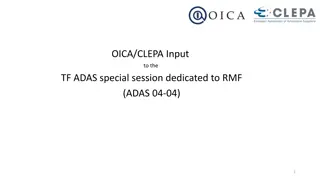Understanding Quality Control: Meaning, Objectives, Functions, and Importance
Quality control is a crucial process where management ensures products meet predetermined standards. It involves assessing quality, locating deviations, suggesting improvements, and reducing wastage. Inspection is essential for verifying product quality and quantity. Maintenance of quality, cost reduction, and product improvement are key outcomes. Explore the scope, devices used, and applicability of quality control methods to achieve better quality and consumer satisfaction.
Download Presentation

Please find below an Image/Link to download the presentation.
The content on the website is provided AS IS for your information and personal use only. It may not be sold, licensed, or shared on other websites without obtaining consent from the author. Download presentation by click this link. If you encounter any issues during the download, it is possible that the publisher has removed the file from their server.
E N D
Presentation Transcript
Quality Control Meaning Objectives Functions Importance Inspection Objectives Types of Inspection Difference between ISO andAGMARK SQC AGMARK ISI and ISO
Quality control means we mean the process of control where the management tries to conform the quality of the product in accordance with the pre-determined standards and specifications. It is a systematic control of those variables that affect the excellence of the ultimate product. It may be defined as that industrial management technique or group of techniques by means of which products of uniform manufactured. acceptable quality are
To assess the quality To see whether the product conforms to the predetermined standards To locate the reason for deviations and to take necessary remedial steps To suggest suitable improvements To develop quality consciousness To assess the various techniques To reduce the wastage
Determining Requirements Keeping records of Quality standards Determining Sampling Limits Better Quality Devices Developed
Reduction in costs Improvement in morale Maximum utilization of resources Increase in sales Consumer s satisfaction
Inspection is the process of examining an object for identification or checking it for verification of quality and quantity in any of its characteristics. It is an important tool for ascertaining and controlling the quality of a product. According to Alford Beatty, it is the art of applying tests preferably by the aid of measuring appliances to observe whether a given item or product is within the specified limits of variability or not .
Maintenance of Quality Improving the Product Quality Reduction in Costs
Scope Definition Devices used Applicability concern
The term agmark comprises of two word agand mark. Ag means agriculture and mark means a certification mark. AGMARK is a certification mark employed mark employed on agricultural products in India, assuring that they conform to a set of standards approved by the Directorate of Marketing and Inspection, an agency of the Government of India. AGMARK is legally enforced in India by the Agricultural Produce(Grading and Marking)Act of 1937 (and amended in 1986). AGMARK commodities spanning a variety of pulses, cereals, essential oils, vegetable oils, fruits and vegetables and semi-processed products like vermicelli etc. standards cover quality guidelines for different
It laid down same specification for the packing, i.e., which type of packing should be used for different type of products It also ensures that whatever is being packed should properly weighed and measured before packing The Agmark Standards have benefited both the producer and the consumer. It is possible for the producer to realize better prices for the product with these certification marks, as it ensures quality and guarantees the wholesomeness of the product for the consumer.
ISI mark is a certification mark for industrial products in India. It is most popular and recognized certification mark in Indian sub continent. This mark ensures that the product confirms to the Indian standards mentioned by Indian Standard Institute. ISI is now known as BIS (Bureau of Indian Standards). It checks the quality and standard of every product and provides them certification mark. ISI mark is mandatory for certifying products to be sold in India.
The goods with ISI marks are subject to good quality control and testing They are produced as per the Indian Standard set by the BIS and thereby have assured quality and performance They are the best safeguards against impure, bogus and substandard commodities The ISI mark is a claim by the producer and is not a mere certificate The mark acts as a third party guarantee about the quality Manufactures are liable to punishment, if they use ISI mark fraudulently.
ISI- Institute ISI standardised products Indian Standard It is an acronum for Agricultural Marketing Only agricultural product may apply for certification There are standards agricultural commodities It indicates the grade. mark used vaiety to of a the agmark varied for grading different It given to items such as packaged powder, cement etc. It seal standardization water, milk represents ISI AGMARK
The international organization for standardization is a specialized agency for standardization. It is a world wide federation of national standards bodies in-more than 100 countries. The Bureau of Indian Standards(BIS) is the national standards body of India represented on ISO. ISO is a based in Geneva, has over 200 technical committees to prepare international standards. It has the main objective of coordination and unification of international standards

















































